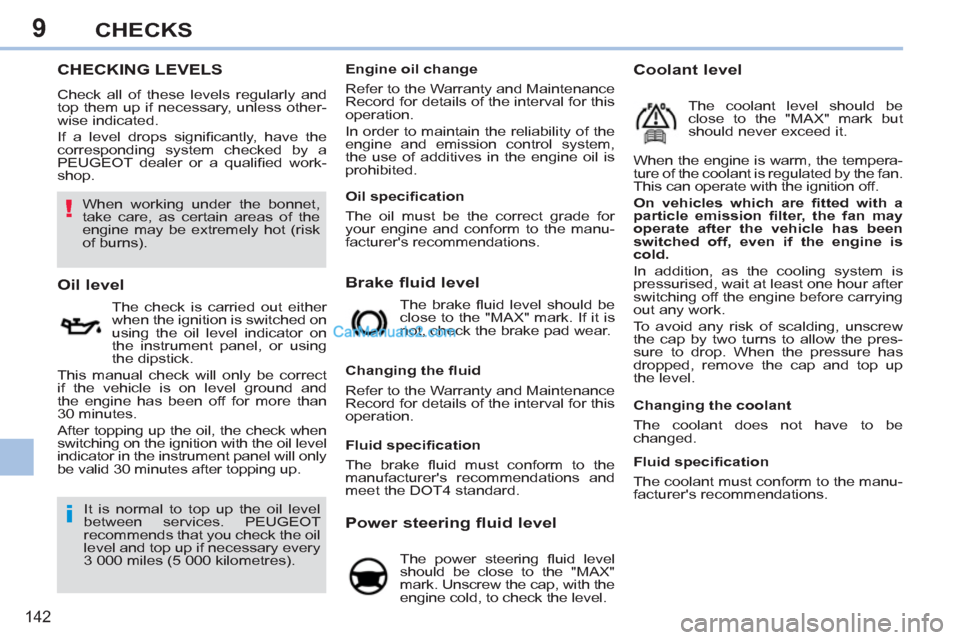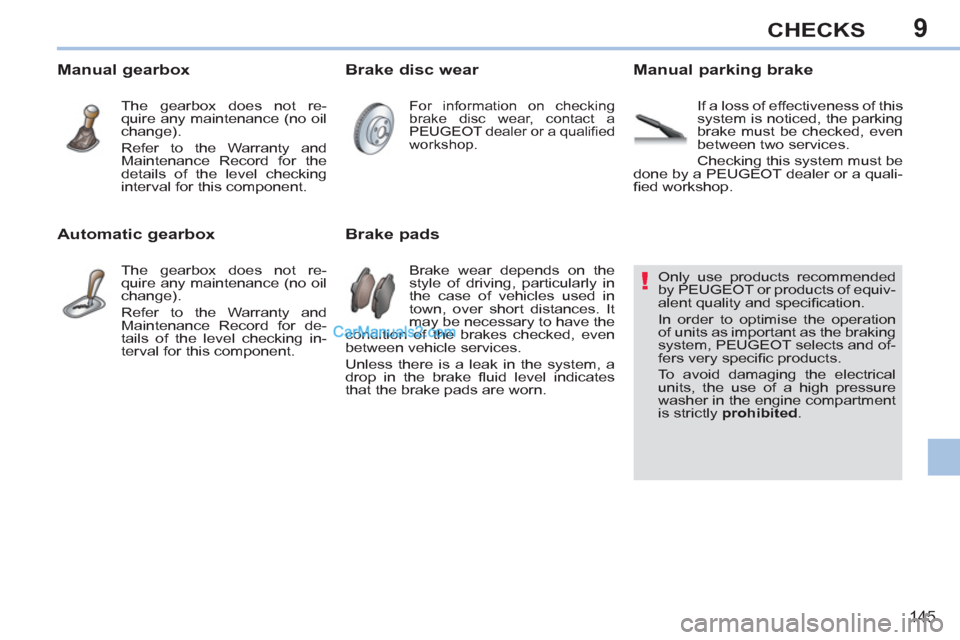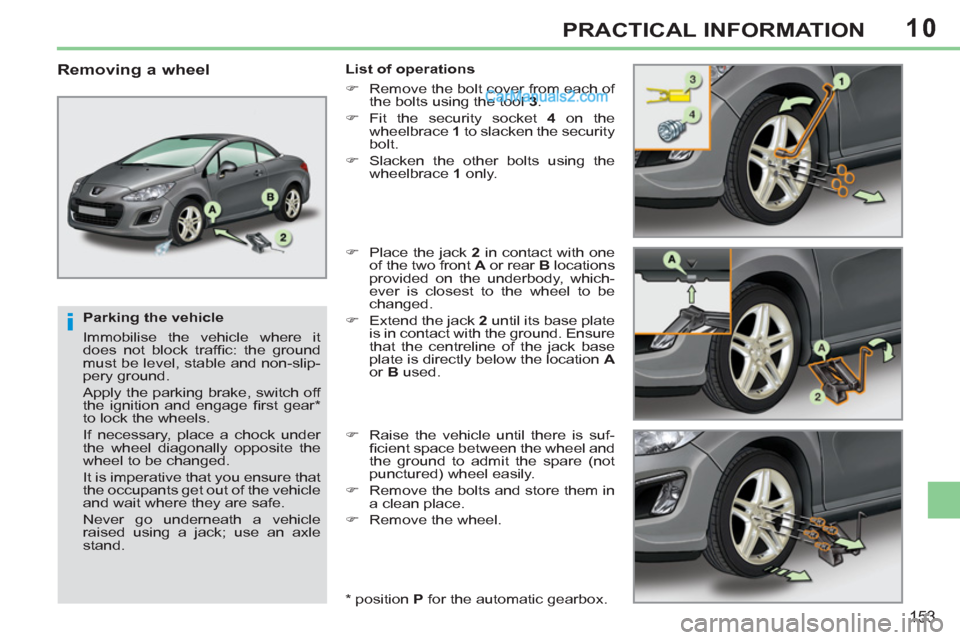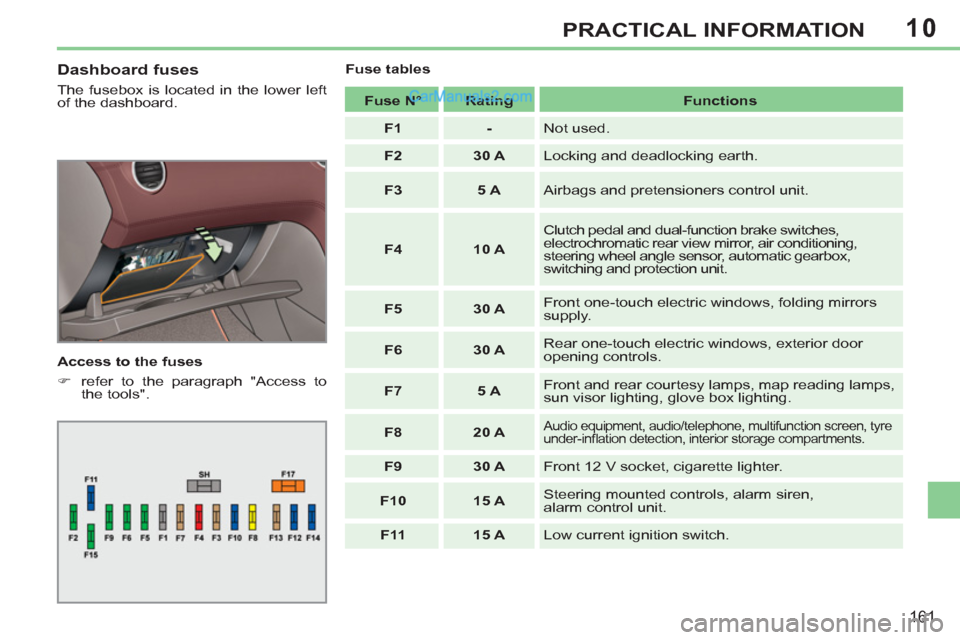Page 143 of 292
9
141
CHECKS
DIESEL ENGINES
The various caps and covers allow ac-
cess for checking the levels of the various
fl uids, for replacing certain components
and for priming the fuel system.
1.
Power steering reservoir.
2.
Screenwash and headlamp wash
reservoir.
3.
Coolant reservoir.
4.
Brake fl uid reservoir.
5.
Battery/Fuses.
6.
Fusebox.
7.
Air fi lter.
8.
Engine oil dipstick.
9.
Engine oil fi ller cap.
10.
Priming pump * .
11 .
Bleed screw * .
* According to engine.
Page 144 of 292

9
!
i
142
CHECKS
CHECKING LEVELS
Check all of these levels regularly and
top them up if necessary, unless other-
wise indicated.
If a level drops signifi cantly, have the
corresponding system checked by a
PEUGEOT dealer or a qualifi ed work-
shop.
Brake fluid level
Oil level
The check is carried out either
when the ignition is switched on
using the oil level indicator on
the instrument panel, or using
the dipstick.
This manual check will only be correct
if the vehicle is on level ground and
the engine has been off for more than
30 minutes.
After topping up the oil, the check when
switching on the ignition with the oil level
indicator in the instrument panel will only
be valid 30 minutes after topping up. The brake fl uid level should be
close to the "MAX" mark. If it is
not, check the brake pad wear.
Power steering fluid level
The power steering fl uid level
should be close to the "MAX"
mark. Unscrew the cap, with the
engine cold, to check the level.
It is normal to top up the oil level
between services. PEUGEOT
recommends that you check the oil
level and top up if necessary every
3 000 miles (5 000 kilometres).
Changing the fl uid
Refer to the Warranty and Maintenance
Record for details of the interval for this
operation. When the engine is warm, the tempera-
ture of the coolant is regulated by the fan.
This can operate with the ignition off.
On vehicles which are fi tted with a
particle emission fi lter, the fan may
operate after the vehicle has been
switched off, even if the engine is
cold.
In addition, as the cooling system is
pressurised, wait at least one hour after
switching off the engine before carrying
out any work.
To avoid any risk of scalding, unscrew
the cap by two turns to allow the pres-
sure to drop. When the pressure has
dropped, remove the cap and top up
the level.
Coolant level
The coolant level should be
close to the "MAX" mark but
should never exceed it.
Changing the coolant
The coolant does not have to be
changed.
When working under the bonnet,
take care, as certain areas of the
engine may be extremely hot (risk
of burns).
Fluid specifi cation
The coolant must conform to the manu-
facturer's recommendations.
Fluid specifi cation
The brake fl uid must conform to the
manufacturer's recommendations and
meet the DOT4 standard.
Oil specifi cation
The oil must be the correct grade for
your engine and conform to the manu-
facturer's recommendations.
Engine oil change
Refer to the Warranty and Maintenance
Record for details of the interval for this
operation.
In order to maintain the reliability of the
engine and emission control system,
the use of additives in the engine oil is
prohibited.
Page 147 of 292

9
!
145
CHECKS
Only use products recommended
by PEUGEOT or products of equiv-
alent quality and specifi cation.
In order to optimise the operation
of units as important as the braking
system, PEUGEOT selects and of-
fers very specifi c products.
To avoid damaging the electrical
units, the use of a high pressure
washer in the engine compartment
is strictly prohibited
.
Brake disc wear
Brake pads
Manual parking brake
Brake wear depends on the
style of driving, particularly in
the case of vehicles used in
town, over short distances. It
may be necessary to have the
condition of the brakes checked, even
between vehicle services.
Unless there is a leak in the system, a
drop in the brake fl uid level indicates
that the brake pads are worn.
For information on checking
brake disc wear, contact a
PEUGEOT dealer or a qualifi ed
workshop.
If a loss of effectiveness of this
system is noticed, the parking
brake must be checked, even
between two services.
Checking this system must be
done by a PEUGEOT dealer or a quali-
fi ed workshop.
Manual gearbox
The gearbox does not re-
quire any maintenance (no oil
change).
Refer to the Warranty and
Maintenance Record for the
details of the level checking
interval for this component.
Automatic gearbox
The gearbox does not re-
quire any maintenance (no oil
change).
Refer to the Warranty and
Maintenance Record for de-
tails of the level checking in-
terval for this component.
Page 155 of 292

10
i
153
PRACTICAL INFORMATION
Parking the vehicle
Immobilise the vehicle where it
does not block traffi c: the ground
must be level, stable and non-slip-
pery ground.
Apply the parking brake, switch off
the ignition and engage fi rst gear *
to lock the wheels.
If necessary, place a chock under
the wheel diagonally opposite the
wheel to be changed.
It is imperative that you ensure that
the occupants get out of the vehicle
and wait where they are safe.
Never go underneath a vehicle
raised using a jack; use an axle
stand.
Removing a wheel
List of operations
�)
Remove the bolt cover from each of
the bolts using the tool 3
.
�)
Fit the security socket 4
on the
wheelbrace 1
to slacken the security
bolt.
�)
Slacken the other bolts using the
wheelbrace 1
only.
�)
Place the jack 2
in contact with one
of the two front A
or rear B
locations
provided on the underbody, which-
ever is closest to the wheel to be
changed.
�)
Extend the jack 2
until its base plate
is in contact with the ground. Ensure
that the centreline of the jack base
plate is directly below the location A
or B
used.
�)
Raise the vehicle until there is suf-
fi cient space between the wheel and
the ground to admit the spare (not
punctured) wheel easily.
�)
Remove the bolts and store them in
a clean place.
�)
Remove the wheel.
* position P
for the automatic gearbox.
Page 160 of 292
10
!
158
PRACTICAL INFORMATION
Rear lamps
1.
Brake lamps (LEDs).
2.
Sidelamps (LEDs).
3.
Direction indicators (LEDs).
4.
Foglamp (P 21W).
5.
Reversing lamp (P 21W).
Changing the foglamp and reversing
lamp bulbs
These two bulbs are changed from out-
side the rear bumper:
On the left-hand side, take care not
to touch the silencer; risk of burns, if
you change the bulb after switching
off the ignition.
�)
turn the bulb holder one quarter of a
turn and remove it,
�)
turn the bulb one quarter of a turn
and change it.
To r efi t, carry out these operations in
reverse order.
Changing brake lamps, sidelamps
and direction indicators
For the replacement of this type of LED
lamp, contact a PEUGEOT dealer or a
qualifi ed workshop.
Page 161 of 292
10
!
159
PRACTICAL INFORMATION
Changing the third brake lamp
(LEDs)
For the replacement of this type of LED
lamp, contact a PEUGEOT dealer or a
qualifi ed workshop.
Changing the number plate lamp
bulbs (W 5 W)
�)
Insert a thin screwdriver in one of
the exterior holes of the lens.
�)
Push it towards the outside to unclip it.
�)
Remove the lens.
�)
Pull the bulb out and change it.
High pressure washing
When using this type of washing
on stubborn dirt, do not persist on
the headlamps, the lamps and their
surrounds to avoid damaging their
protective coating and seals.
Page 163 of 292

10
161
PRACTICAL INFORMATION
Dashboard fuses
The fusebox is located in the lower left
of the dashboard.
Access to the fuses
�)
refer to the paragraph "Access to
the tools".
Fuse tables
Fuse N°
Rating
Functions
F1
-
Not used.
F2
30 A
Locking and deadlocking earth.
F3
5 A
Airbags and pretensioners control unit.
F4
10 A
Clutch pedal and dual-function brake switches,
electrochromatic rear view mirror, air conditioning,
steering wheel angle sensor, automatic gearbox,
switching and protection unit.
F5
30 A
Front one-touch electric windows, folding mirrors
supply.
F6
30 A
Rear one-touch electric windows, exterior door
opening controls.
F7
5 A
Front and rear courtesy lamps, map reading lamps,
sun visor lighting, glove box lighting.
F8
20 A
Audio equipment, audio/telephone, multifunction screen, tyre
under-infl ation detection, interior storage compartments.
F9
30 A
Front 12 V socket, cigarette lighter.
F10
15 A
Steering mounted controls, alarm siren,
alarm control unit.
F11
15 A
Low current ignition switch.
Page 167 of 292
10
!
165
PRACTICAL INFORMATION
Table of fuses above the battery
Fuse N°
Rating
Functions
F1
-
Not used.
F2
5 A
Dual-function brake switch.
F3
5 A
Battery charge unit.
F4
25 A
ABS/ESP electrovalves.
F5
-
Not used.
F6
15 A
Automatic gearbox.
All work on the other type of fuses must only be done by a PEUGEOT dealer
or a qualifi ed workshop.